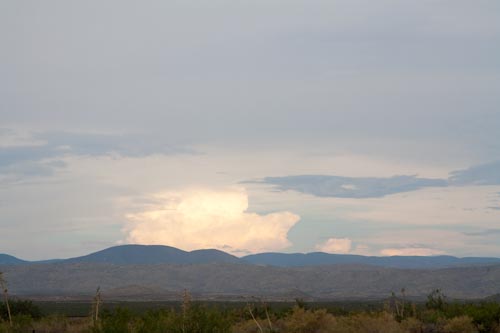Today is the 65th anniversary of the detonation of the first atomic bomb in a remote part of the Southern New Mexican desert called Jornado del Muerto. At least 64 ranches and three camps within a 30 mile radius of the test were not evacuated. Residents, with no advance warning of the secret test, stood and watched, sometimes for hours.
How is that many local citizens witnessed the bright light before dawn, heard and felt the thunder of an unexplained explosion?
No one outside of the Army and a few scientists, including my grandfather Enrico Fermi were supposed to know of the test. My grandmother, safe in bed in Los Alamos, hundreds of miles to the north, only knew her husband was gone for a good part of the night.
No one was supposed to have been harmed. A few months ago, I was shocked to learn otherwise. And now that I know I feel sorrow.
Tonight in Tularosa, a village to the south-east of the Trinity test, communities are joining local residents to remember those who died of cancer as a result of radiation exposure. Those who are still alive will share their stories. Whole families lost to cancer. Livestock who faced the blast, blinded. Livestock which stood sideways as the blast came, turned white on one side.
Tina Cordova, Tularosa Basin Downwinders Consortium invited me to the gathering this weekend in Tularosa, to hear stories, to meet the many women, youth (and yes men too) who have created a web of community groups which both empower local people and advocate for environmental justice. Tomorrow I will give a presentation to the community to wrap up the weekend events .
Las Mujeres Hablan (the women speak) is one such group. And they, along with all of us, also have reason to celebrate this weekend.
For ten years the Center for Disease Control (CDC) has been conducting an in-depth environmental impact study of Los Alamos National Labs called Los Alamos Historic Document Review and Assessment (LAHDRA) (Chap 10 is on the Trinity Test findings). At times it looked as if the study would not be completed. Las Mujeres played a key role in keeping the study alive. The final draft has already been released and the report itself will be released in September 2010.
It provides much of the definitive evidence residents of New Mexico needed. Twenty years after the initial Radiation Exposure Compensation Act (RECA) was passed, there are tangible signs that Congress will finally include the first downwinders in the legislation. RECA is up for review for the third time in it’s history and there is strong support to include victims of the Trinity test in the new bill.
The tremendous effort of local citizens, represented by Native groups, environmental groups, community groups and youth groups inspires and moves me.



 Twitter
Twitter
Pingback: Hiroshima, Petropolis and Trinity | On the Neutron Trail